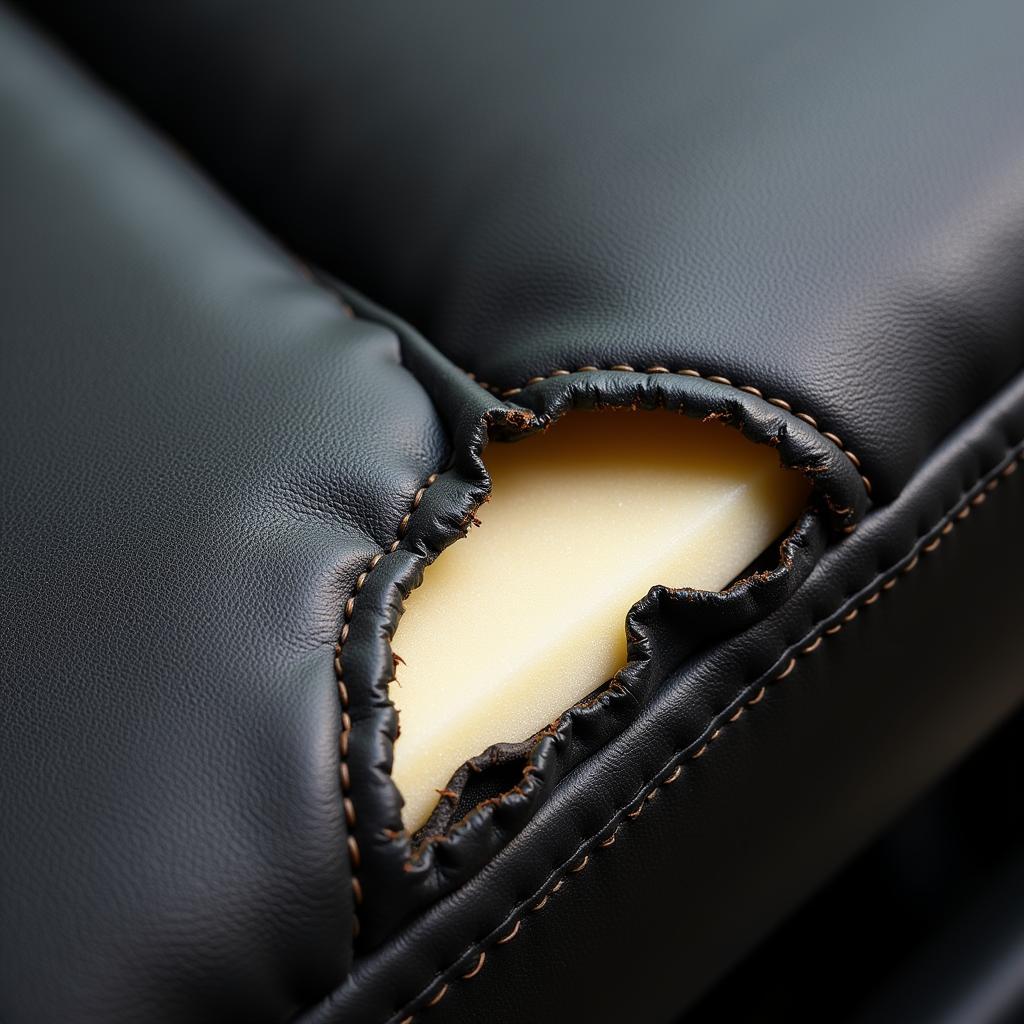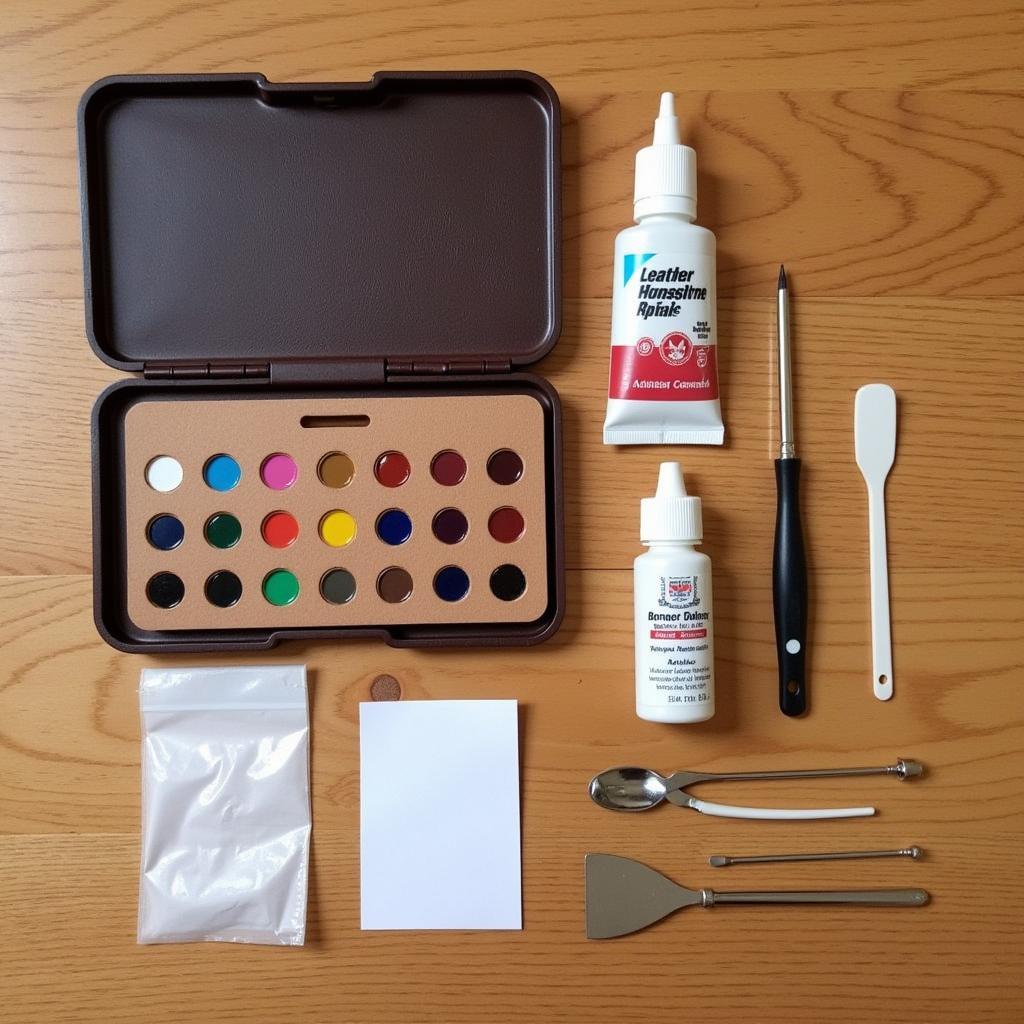Ripped leather car seats can be an eyesore and decrease the value of your vehicle. However, with the right techniques and a little patience, Fixing Ripped Leather Car Seats is often possible without professional help. This guide will walk you through various methods, from simple DIY fixes to more involved repairs.
 Close-up of a ripped leather car seat showing the damage
Close-up of a ripped leather car seat showing the damage
Why Do Leather Car Seats Rip?
Leather car seats, while durable, are susceptible to wear and tear. Common causes of rips include sharp objects, pet claws, and even the friction from getting in and out of the car. Over time, the leather can dry out and become more prone to cracking and tearing. Proper care and maintenance can prevent some of this damage, but knowing how to repair it when it happens is essential.
DIY Fixes for Minor Rips
For small rips and tears, you can often achieve satisfactory results with DIY methods. Leather repair kits are readily available and provide everything you need for a basic repair. These kits typically include a leather filler, adhesive, color-matching compounds, and application tools. Remember to clean the area thoroughly before applying any repair materials.
 Contents of a leather repair kit laid out on a table
Contents of a leather repair kit laid out on a table
Using a Leather Repair Kit: A Step-by-Step Guide
- Clean the area: Use a leather cleaner to remove dirt and debris from the ripped area and surrounding leather.
- Apply the filler: Carefully fill the tear with the leather filler, ensuring a smooth and even surface.
- Let it dry: Allow the filler to dry completely according to the manufacturer’s instructions.
- Apply the adhesive: Apply the adhesive to the backing fabric of the tear to secure it in place.
- Color matching: Mix the color compounds provided in the kit to match your car seat’s leather color. Apply the colorant to the repaired area, blending it seamlessly with the surrounding leather.
“A common mistake is not allowing the filler to dry completely before applying the colorant,” advises John Smith, a veteran automotive leather repair specialist. “This can lead to a sticky finish and uneven color.”
Professional Repair for Major Damage
While DIY solutions are great for minor rips, larger tears or extensive damage may require professional intervention. A professional auto upholstery shop has the expertise and specialized tools to handle complex repairs. They can often restore even severely damaged leather seats to near-original condition.
When to Call a Professional
- Large tears: If the tear is longer than a few inches or involves complex shapes, it’s best to consult a professional.
- Deep damage: Tears that penetrate through the leather and into the underlying foam require specialized techniques.
- Multiple tears or widespread damage: Attempting to repair multiple tears yourself can be challenging and may not yield satisfactory results.
Preventing Future Rips
Prevention is always better than cure. Here are some tips to protect your leather car seats and prevent future rips:
- Regular cleaning and conditioning: Keep your leather seats clean and moisturized with a dedicated leather conditioner. This helps prevent drying and cracking, making them less susceptible to tearing.
- Avoid sharp objects: Be mindful of what you bring into your car. Avoid carrying sharp objects that could potentially scratch or puncture the leather.
- Pet protection: Use seat covers or pet hammocks to protect your seats from pet claws.
- Careful entry and exit: Avoid sliding or rubbing against the seats when getting in and out of the car.
“Think of your leather seats like your skin – they need regular care and protection to stay healthy,” says Maria Garcia, a leading automotive interior design consultant. “Regular conditioning can significantly extend the life of your leather.”
Conclusion
Fixing ripped leather car seats can range from a simple DIY project to a more complex professional repair. By following the guidelines in this article, you can choose the best approach for your specific situation and restore your car’s interior to its former glory. For any further assistance or advice, feel free to connect with us at AutoTipPro at +1 (641) 206-8880 or visit our office at 500 N St Mary’s St, San Antonio, TX 78205, United States.
FAQ
- Can I use super glue to fix a ripped leather car seat? While super glue might seem like a quick fix, it’s not recommended for leather repair. It can create a stiff, brittle bond that will likely crack and peel over time.
- How much does professional leather car seat repair cost? The cost varies depending on the extent of the damage and the type of leather. It’s best to get a quote from a reputable auto upholstery shop.
- What’s the best way to clean leather car seats? Use a dedicated leather cleaner and conditioner to keep your seats clean and moisturized.
- How often should I condition my leather car seats? Conditioning every few months, or as needed, is recommended, especially in dry climates.
- Can I repair a ripped leather car seat with duct tape? Duct tape is a temporary fix at best and will likely leave residue and damage the leather further. It’s not a recommended solution.
- What if the tear is on the seam of the car seat? Tears on the seam often require more specialized stitching and are best handled by a professional.
- Where can I find a reputable auto upholstery shop near me? Online searches and local directories can help you find qualified auto upholstery shops in your area. Be sure to check reviews and compare prices before making a decision.




Leave a Reply